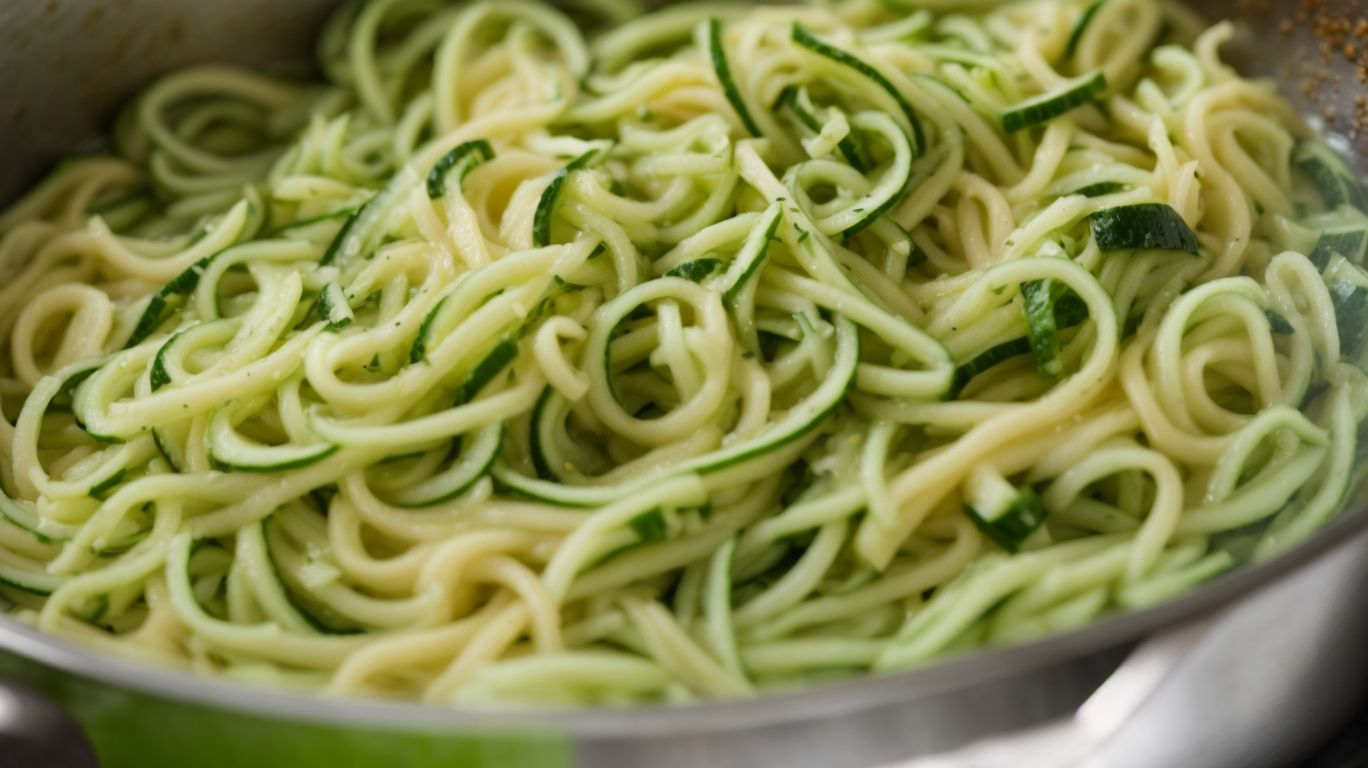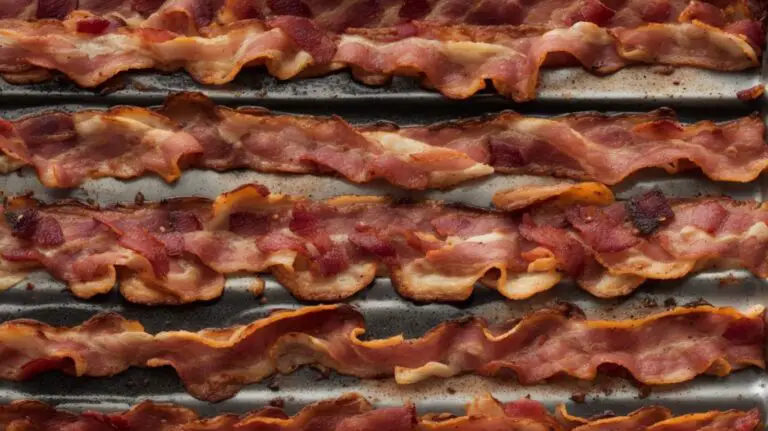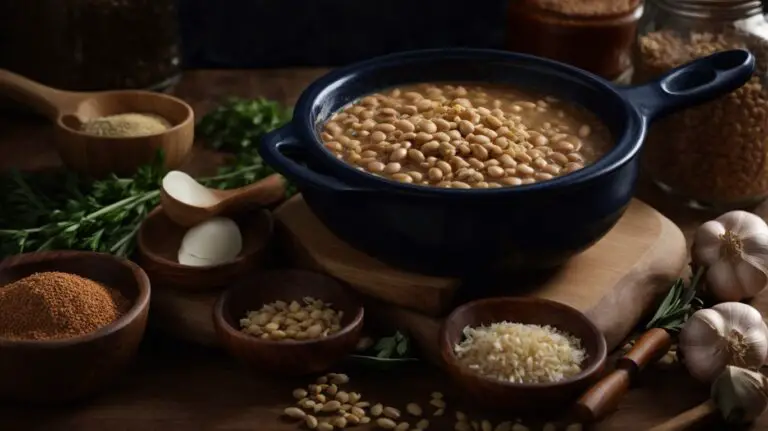How to Cook Zucchini Noodles Without Getting Soggy?
Looking for a healthy alternative to traditional pasta?
Zucchini noodles, also known as zoodles, are a fantastic option that is not only low in carbs but also packed with nutrients.
We will explore why zucchini noodles are a great choice, how to prepare them properly, and most importantly, how to prevent them from getting soggy.
Learn expert tips on cooking and serving zucchini noodles that will elevate your dish to a whole new level!
Key Takeaways:
Why Use Zucchini Noodles?
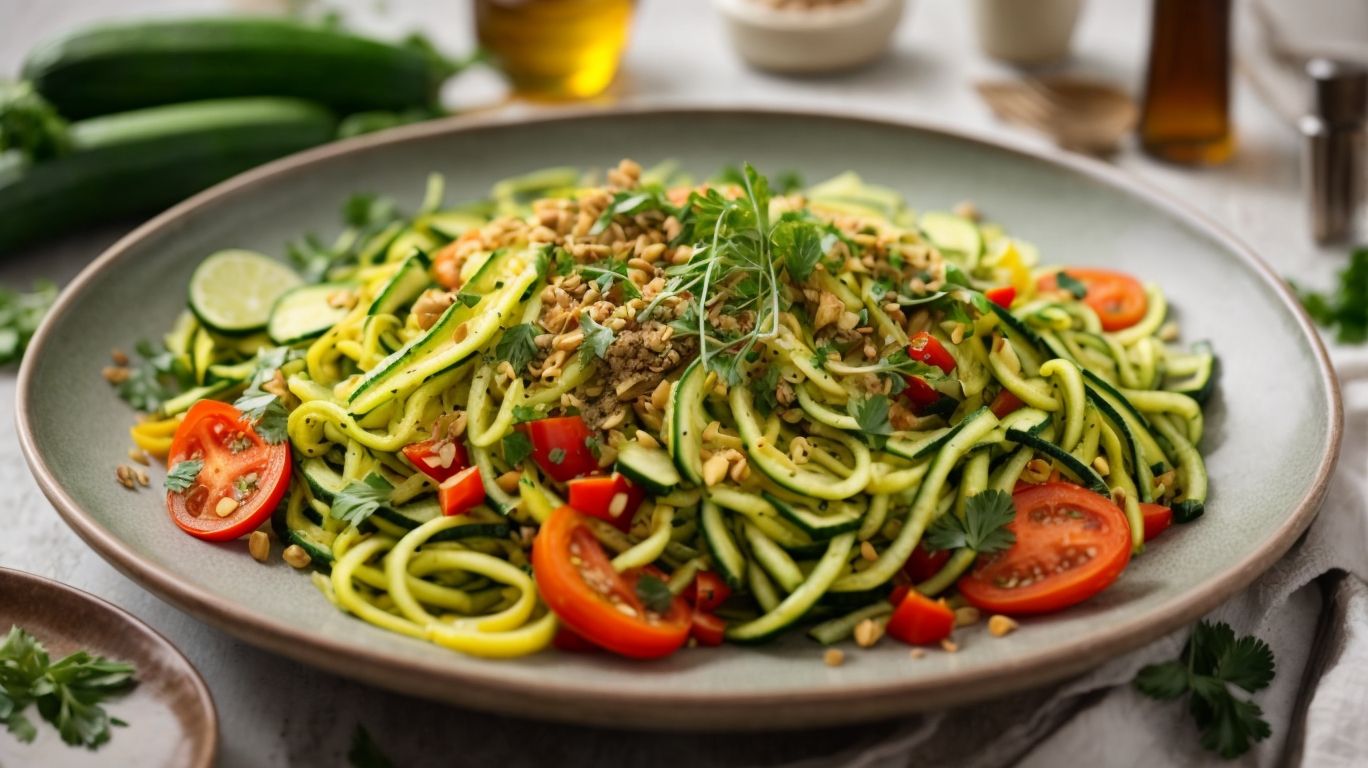
Credits: Poormet.Com – Jason Sanchez
Zucchini noodles, also known as zoodles, are a nutritious and low-calorie alternative to traditional pasta, making them an excellent choice for those seeking a healthier meal option.
Not only are zucchini noodles a great way to increase your vegetable intake, but they are also packed with essential nutrients such as vitamin C and potassium. These nutrients play a crucial role in supporting your immune system and maintaining healthy blood pressure levels.
What’s fantastic about zoodles is their versatility in recipes; you can use them in salads, stir-fries, or even as a topping for your favorite Italian dishes. By swapping regular pasta with zucchini noodles, you can significantly reduce your calorie intake while still enjoying a delicious homemade meal.
How to Prepare Zucchini Noodles?
Preparing zucchini noodles involves selecting the right zucchini, washing, drying, and cutting them into noodle-like shapes using a spiralizer or other kitchen tools.
When selecting zucchini for your noodle recipe, opt for firm and straight zucchinis without any blemishes or soft spots. Give them a good rinse under cold water to remove any dirt or residues. Next, pat them dry using a kitchen towel or paper towel to ensure they are not too wet, as excess moisture can make the noodles soggy.
For the cutting process, you can use a spiralizer to create long, thin zucchini noodles effortlessly. If you don’t have a spiralizer, a julienne peeler or mandoline slicer can also do the trick. Make sure to cut the zucchini evenly to ensure consistent cooking.
Experiment with different zucchini noodle recipes and cooking methods to find your favorite. Whether you sauté them with garlic and olive oil or toss them in a vibrant pesto sauce, zucchini noodles are a versatile and healthy alternative to traditional pasta dishes.
Choosing the Right Zucchini
Selecting the right zucchini is crucial for ensuring the best texture and flavor in your zucchini noodles. Look for firm, fresh zucchinis with vibrant green skin and no signs of soft spots or blemishes.
Another important factor to consider when choosing zucchinis for zoodles is the size of the vegetable. Opt for medium-sized zucchinis as they tend to have a good balance of moisture content, making them ideal for spiralizing into noodles. Remember, larger zucchinis may have larger seeds and a more watery flesh, which can affect the overall consistency of your zoodles.
Additionally, organic zucchinis are a great choice if available. These are free from pesticides and other harmful chemicals, enhancing both the taste and nutritional value of your zoodles. Seasonal zucchinis are often fresher and more flavorful, making them perfect for creating delicious zoodle dishes.
Washing and Drying the Zucchini
To prevent your zucchini noodles from turning watery during cooking, it is essential to wash and dry the zucchini thoroughly before spiralizing. This helps remove excess moisture and ensures a better texture for your dish.
After washing the zucchini, pat it dry with a kitchen towel or paper towels to absorb any remaining water. Some cooks even go a step further and lightly salt the zucchini noodles to draw out additional moisture before cooking. By employing this method, you can significantly reduce the risk of ending up with soggy zucchini noodles that might dilute the flavors of your dish. It’s a simple yet crucial step in the preparation process that can elevate the overall culinary experience.
Cutting the Zucchini into Noodles
Cutting zucchinis into noodle shapes can be achieved efficiently with the help of a spiralizer, ensuring uniform thickness and texture for your zoodles. Alternatively, you can use a mandoline slicer or a sharp knife for this purpose.
When using a spiralizer, begin by trimming the ends of the zucchini to create flat surfaces for better stability. Then, secure the zucchini onto the spiralizer and crank the handle to produce long, curly zucchini noodles. Adjust the settings on the spiralizer to control the thickness of the noodles based on your preference.
If using a mandoline slicer, make sure to choose a julienne blade for creating noodle shapes. Carefully slide the zucchini along the slicer to achieve consistent slices resembling noodles. Remember to use the hand guard for safety to avoid any accidents.
How to Prevent Zucchini Noodles from Getting Soggy?
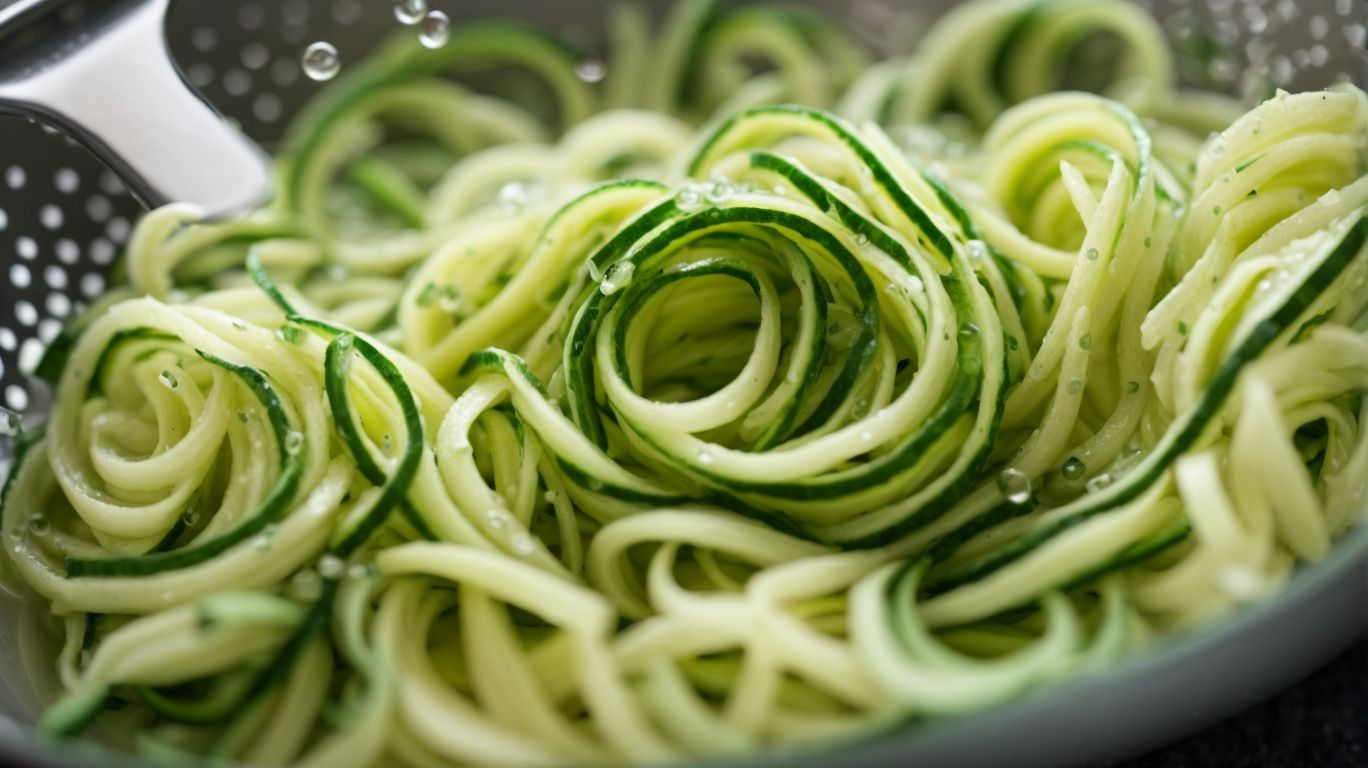
Credits: Poormet.Com – Edward Scott
Preventing zucchini noodles from becoming soggy can be achieved through various methods such as salting the zoodles, squeezing out excess moisture, and using appropriate cooking techniques like sautéing to maintain their firmness and texture.
Incorporating these strategies can significantly enhance the overall quality of your zucchini noodle dishes. When you avoid skipping the salting process, it helps to draw out the excess water from the zucchinis, preventing them from turning mushy.
Delicately squeezing the zoodles after salting aids in reducing the moisture content further, ensuring a crispier texture post-cooking.
Choosing to sauté zucchini noodles instead of boiling or steaming them helps maintain their firmness and allows for quick cooking without excessive moisture absorption.
Salting the Zucchini Noodles
Salting zucchini noodles before cooking helps draw out excess water, reducing the chances of sogginess and ensuring a firmer texture in the final dish. This simple technique can significantly enhance the quality of your zoodle-based meals.
By salting zucchini noodles, you allow the water to be released, thereby preventing your dish from turning into a watery mess. Not only does this method improve the texture of the zoodles, but it also helps concentrate the flavors of the seasoning or sauce you’ll be adding later on.
The process usually involves sprinkling the zucchini noodles with salt and letting them sit for about 15-30 minutes. After that, gently squeezing out the excess liquid with a paper towel or a clean cloth can make a world of difference in the final outcome.
Squeezing the Excess Moisture Out
After salting the zucchini noodles, it’s essential to squeeze out the excess moisture using a clean kitchen towel or paper towels. This step helps maintain the desired consistency and prevents the dish from becoming too watery during cooking.
Once you have sprinkled the zucchini noodles with salt and allowed them to sit for a while, you will notice droplets of excess moisture forming. Gently pressing the towels onto the noodles will help draw out the water, leaving you with a texture that is firm and not mushy.
Consistency is key here; if the excess moisture is not removed properly, your dish may end up soggy and lacking in flavor.
Using a Spiralizer
Utilizing a spiralizer is a convenient and efficient way to create uniform zucchini noodles of consistent thickness, enhancing the visual appeal and texture of your dishes. Experiment with different blade settings for varied noodle shapes.
By adjusting the blade, you can achieve thin angel hair noodles, wider fettuccine-style ribbons, or even thicker pappardelle strands, allowing for versatile culinary creations. The variety in shapes not only adds visual appeal to your dishes but also offers different textures and mouthfeels.
Spiralizing helps you incorporate more vegetables into your diet in a fun and creative way, making it appealing even to picky eaters. Zucchini noodles produced by a spiralizer can be a healthy low-carb alternative to traditional pasta, perfect for those looking to reduce their carbohydrate intake while still enjoying delicious meals.
Cooking the Noodles in Small Batches
When cooking zucchini noodles, it’s advisable to work in small batches to prevent overcrowding the pan, which can lead to excess moisture accumulation and result in soggy noodles. Opt for quick stir-fry methods for best results.
Cooking zucchini noodles in small batches allows for even heat distribution and ensures that each noodle gets properly cooked without becoming mushy. This method also helps in maintaining the vibrant color and texture of the zoodles.
Stir-frying zucchini noodles quickly over high heat not only preserves their crunchiness and flavor but also retains their nutritional value. Make sure to keep the pan hot and constantly toss the noodles to prevent them from sticking or turning soggy.
Not Overcooking the Noodles
To preserve the desired texture and prevent zucchini noodles from turning mushy or soggy, it’s crucial not to overcook them. Aim for a quick cooking time to retain a slight crunch and freshness in the zoodles.
When zucchini noodles are overcooked, they lose their firmness and can become limp, detracting from the overall dish. By keeping a close eye on the cooking duration and removing the noodles promptly once they are just tender, you ensure that they maintain their perfect al dente consistency.
Remember, zucchini naturally contains a high water content, which can contribute to sogginess if not managed correctly during cooking. To prevent this, consider salting the zoodles beforehand to draw out excess moisture, then swiftly sauté or stir-fry them to achieve that ideal balance of firmness and tenderness.
What Are Some Tips for Cooking Zucchini Noodles?
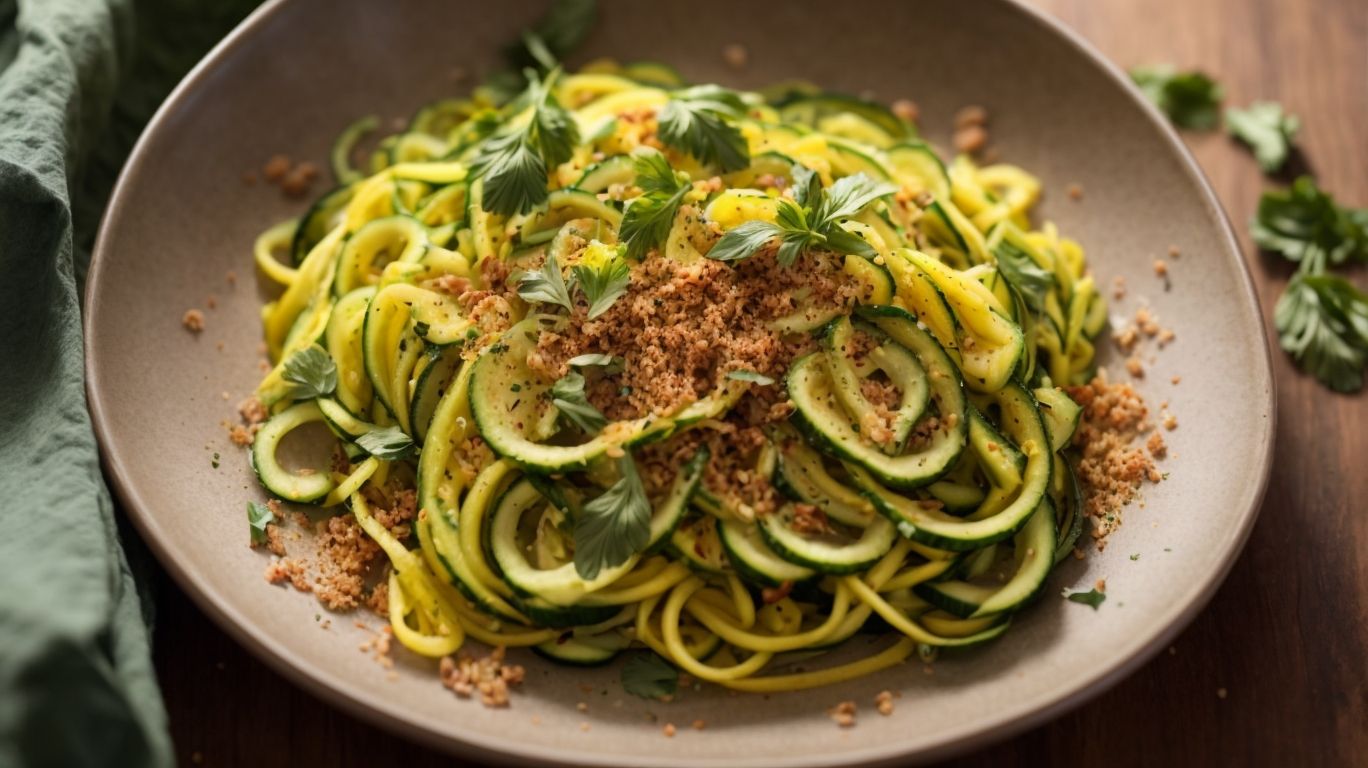
Credits: Poormet.Com – Raymond Hall
Enhance your zucchini noodle dishes by incorporating flavorful ingredients, choosing the right cooking method, mixing with complementary vegetables, and adding delicious sauces or dressings to elevate the overall taste and appeal of your meals.
When selecting zucchinis for your noodles, opt for firm, medium-sized ones without blemishes. For cooking techniques, try quick stir-fries to maintain a slight crunch, or blanch them briefly for a softer texture. To enhance flavors, experiment with garlic, herbs, or a splash of lemon juice. Pair your zoodles with vibrant bell peppers, cherry tomatoes, or earthy mushrooms for a well-balanced dish. Don’t forget to drizzle with a homemade pesto or a tangy balsamic glaze for an extra burst of flavor.
Adding Flavorful Ingredients
Infuse your zucchini noodle creations with a variety of flavorful ingredients such as garlic, olive oil, fresh herbs, and spices to enhance the taste profile and create a satisfying culinary experience.
Using fresh garlic can add a bold, aromatic kick to your zucchini noodles while olive oil provides a smooth richness that binds all the flavors together. Experiment with different herbs like basil, parsley, or thyme to bring fresh, earthy notes to your dish.
Spices like red pepper flakes, paprika, or cumin can introduce layers of complexity and heat, allowing you to customize the flavor profile to your preference. Remember, the key is to balance these ingredients to create a harmonious blend that complements the natural sweetness of the zucchini.
Using the Right Cooking Method
Opting for the right cooking method, such as quick stir-frying or minimal sautéing, can help preserve the natural crunch and texture of zucchini noodles while allowing the flavors to meld harmoniously.
When stir-frying zucchini noodles, it’s essential to keep the heat high and work quickly to prevent them from becoming soggy. Season with a dash of salt and pepper, and toss them in the pan for a couple of minutes until tender yet still slightly firm.
On the other hand, sautéing zucchini noodles involves a gentle cooking process in a bit of oil, maintaining a medium-low heat to avoid overcooking. Add garlic, herbs, or a squeeze of lemon juice for a burst of flavor that complements the natural taste of the zucchini.
Mixing with Other Vegetables
Blend zucchini noodles with an assortment of fresh vegetables like cherry tomatoes, bell peppers, or spinach to add color, nutrients, and a variety of textures to your dish, creating a vibrant and wholesome meal.
By combining zucchini noodles with other vegetables, you not only increase the fiber and vitamin content of your meal but also introduce a delightful mix of flavors and colors. Pairing zoodles with veggies like carrots, mushrooms, and broccoli offers a diverse range of textures – from crunchy to tender – making each bite interesting and satisfying.
This vegetable mix provides a lighter alternative to traditional pasta, reducing the overall calorie and carb intake while boosting the antioxidant properties and aiding in digestion. Adding a variety of vegetables not only enhances the nutritional profile of your dish but also contributes to a visually appealing presentation, making it a feast for both the eyes and the taste buds.
Adding a Sauce or Dressing
Elevate the taste of zucchini noodles by drizzling them with a flavorful sauce or dressing, such as a light olive oil and garlic sauce, a creamy almond flour-based dressing, or a zesty tomato and red pepper concoction.
Regarding choosing the right sauce or dressing for your zucchini noodles, consider experimenting with different flavor profiles to add variety to your meals. For a fresh and herby twist, you can opt for a basil pesto sauce or a tangy lemon and parmesan dressing. If you prefer a spicier kick, a chili-infused soy sauce or a ginger and sesame dressing can bring bold flavors to your zoodles.
Pairing ideas are also crucial in enhancing the overall dish. Consider serving your zucchini noodles with a rich creamy mushroom sauce, which complements the lightness of the noodles perfectly. Alternatively, a tangy balsamic glaze can add depth and sweetness to the zoodles, making for a delightful combination of flavors.
How to Serve and Store Zucchini Noodles?
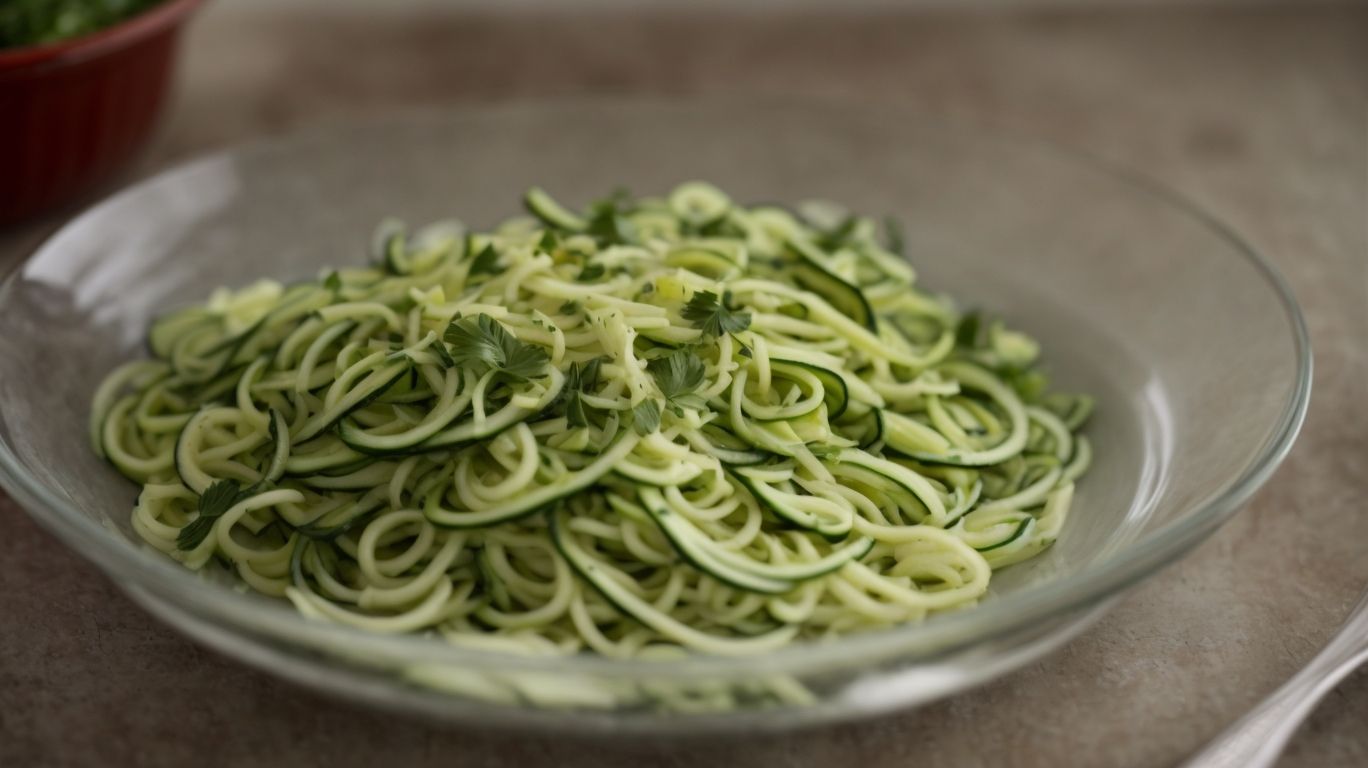
Credits: Poormet.Com – Dennis Lewis
Serve zucchini noodles as a delicious and nutritious alternative to pasta, pairing them with protein-rich toppings, salads, or as a side dish. Store leftover zoodles in airtight glass containers in the refrigerator for future use.
For an elegant presentation, garnish your zoodles with fresh herbs, a drizzle of olive oil, and a sprinkle of Parmesan cheese. These noodles also make a great addition to Buddha bowls, stir-fries, or even as a base for vegetable lasagna. To enhance the flavor profile, consider adding roasted cherry tomatoes, grilled chicken, or sautéed shrimp to your zucchini noodles.
Regarding storing zoodles, glass containers are ideal as they help maintain freshness and prevent odors from seeping in. To preserve them for longer periods, you can also freeze zucchini noodles by blanching them in boiling water for a minute, then plunging them into ice water before draining and freezing in airtight bags.
Serving Suggestions
When serving zucchini noodles, consider pairing them with protein-rich dishes such as grilled chicken, shrimp, or tofu, or incorporate them into salads, stir-fries, or nourishing Buddha bowls for a complete and satisfying meal.
To enhance the flavors in your zucchini noodle dish, you can top them with a sprinkle of Parmesan cheese, fresh herbs, or a drizzle of olive oil for added richness. For a heartier meal, serve the zucchini noodles alongside a generous portion of garlic bread or a side of roasted vegetables. The versatility of zucchini noodles allows for endless possibilities in the kitchen—try adding them to spaghetti sauce for a low-carb twist on classic spaghetti or mix them with pesto for a refreshing summer pasta dish.
Storing Leftover Zucchini Noodles
To store leftover zucchini noodles, transfer them to airtight glass containers, seal them securely, and refrigerate them promptly. Enjoy within a few days by reheating gently or incorporating them into cold salads or wraps for quick and convenient meals.
Proper storage is key to maintaining the freshness and flavor of your leftover zucchini noodles. When choosing containers, opt for glass over plastic to prevent any potential chemical leaching. Glass containers are also durable and easy to clean, making them a sustainable choice for storing your food.
After transferring your zucchini noodles to the glass container, ensure a tight seal to prevent air exposure that can accelerate spoilage. Place the containers in the refrigerator rather than the freezer to maintain the noodles’ texture and taste.
For creative reuse ideas, consider incorporating leftover zucchini noodles into omelets, frittatas, or stir-fries for a delicious twist on classic recipes. By experimenting with different flavor combinations, you can elevate your meals with the addition of these versatile noodles.
Frequently Asked Questions
What are zucchini noodles and why do they get soggy when cooked?
Zucchini noodles, also known as zoodles, are thin strips of zucchini that are often used as a healthier alternative to traditional pasta. They can become soggy when cooked because zucchini has a high water content, which is released during the cooking process.
How can I prevent my zucchini noodles from getting soggy?
To prevent your zucchini noodles from getting soggy, you can salt them before cooking. Sprinkle salt on the noodles and let them sit for about 15 minutes, then use a paper towel to gently squeeze out the excess water.
Can I use a microwave to cook zucchini noodles without getting them soggy?
Yes, you can use a microwave to cook zucchini noodles without getting them soggy. Place the noodles in a microwave-safe dish, cover with a lid or plastic wrap, and cook for 2-3 minutes. The steam will help cook the noodles without releasing too much water.
How do I cook zucchini noodles on the stove without making them soggy?
To cook zucchini noodles on the stove without getting them soggy, use a non-stick pan and cook them over medium-high heat for 3-4 minutes. Keep stirring the noodles to evenly cook them and prevent them from sticking to the pan.
Are there any other methods to cook zucchini noodles without getting them soggy?
Yes, you can also try roasting or grilling zucchini noodles to avoid them getting soggy. This method will give the noodles a slightly crispy texture, making them a great alternative to pasta in dishes like stir-fries or salads.
What are some recipes that use zucchini noodles without making them soggy?
There are many delicious recipes that use zucchini noodles without making them soggy. Some popular options include zucchini noodle Alfredo, zucchini noodle lasagna, and zucchini noodle pad Thai. Get creative and experiment with different sauces and toppings to find your favorite recipe.

